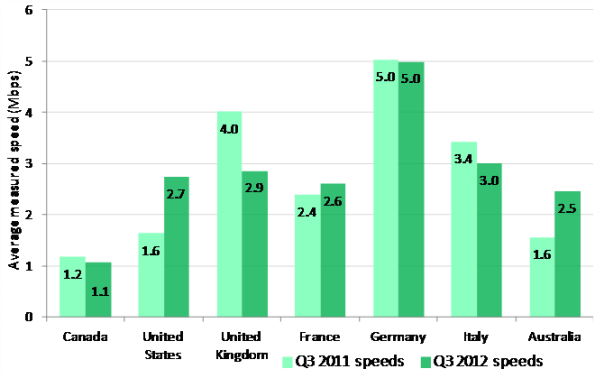When I studied statistics, we were told to look for “outliers” – results that appeared to be inconsistent with the rest of the data. If an observation is a potential outlier, you begin an analysis to determine whether a cause can be identified for the spurious result.
So, in the CRTC Communications Monitoring Report, Figure 7.1.8 has a curious, if not spurious result in its representation of mobile broadband average measured speeds in various countries.

Canada shows a measured speed in 2012 of just 1.1Mbps, a decrease from 2011 that observed 1.2 Mbps. So, despite the expansion of faster networks – the CRTC press release mentioned that LTE was available to 72% of Canadians, up from 45% – Figure 7.1.8 shows observed speeds declining. One might have expected the speeds to be increasing.
That struck me as an outlier meriting further analysis.
I went to the Akamai source document to see what might be the cause. It turns out that Akamai – and therefore, the CRTC – only had one carrier represent Canada for its characterization of mobile broadband speeds. The carrier is identified as CA-2. It may not be one of the major carriers, since Akamai discards results from carriers that mix their fixed broadband and wireless traffic:
Data is included only for networks where Akamai believes that the entire Autonomous System (AS) is mobile—that is, if a network provider mixes traffic from fixed/wireline (DSL, cable, etc.) connections with traffic from mobile connections on a single network identifier, that AS was not included in the source data set.
It appears that the rest of the CRTC table uses the observation from just one carrier from countries that have multiple service providers in the Akamai report, not the average of the observed speeds. For example, Akamai shows the following average kbps for Germany in its 3Q12 report: Germany DE-1 1543; Germany DE-2 4985; Germany DE-3 2094. The CRTC appears to list the result for DE-2 only.
Figure 7.1.8 appears to be an outlier that needs further analysis.
Update: US Telecom, formerly known as the United States Telephone Association, has just published an analysis of Internet traffic data and it is worth reading as we examine international telecom performance.
Two graphics in particular caught my eye:


